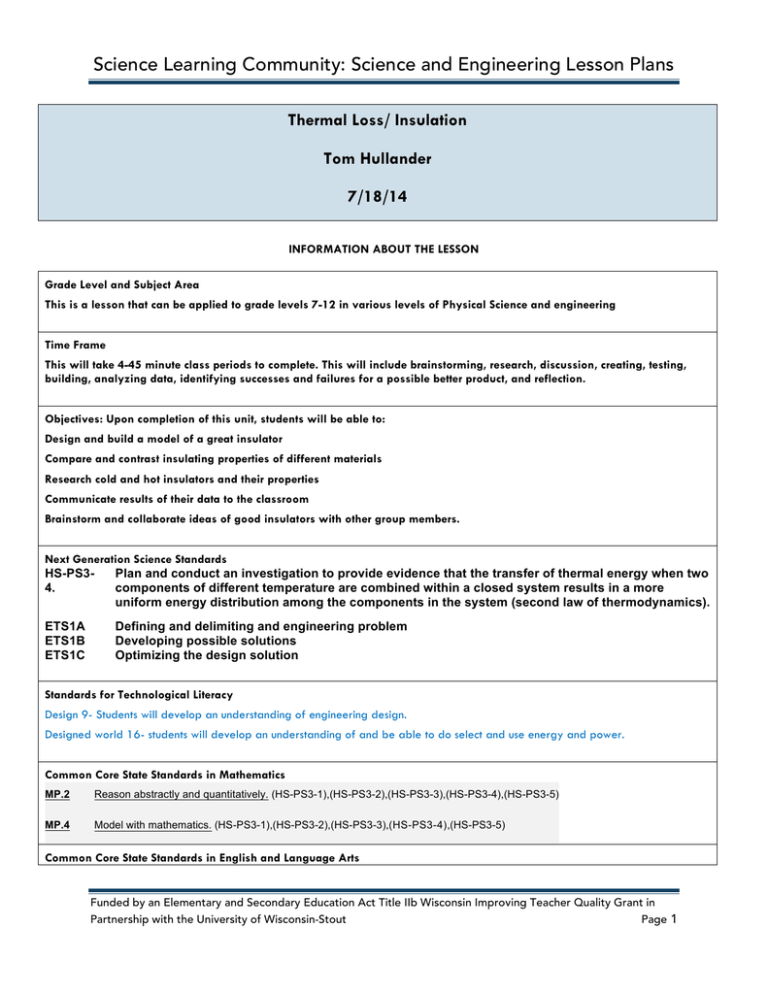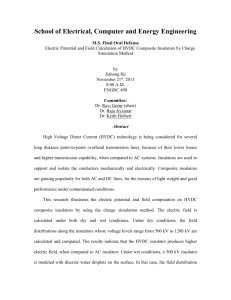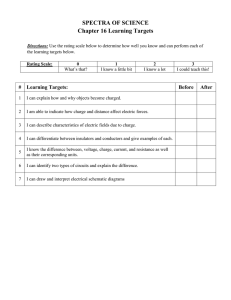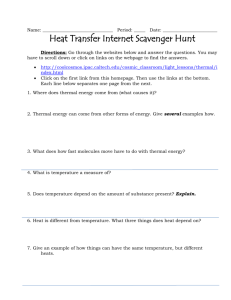Science Learning Community: Science and Engineering Lesson Plans Thermal Loss/ Insulation
advertisement

Science Learning Community: Science and Engineering Lesson Plans Thermal Loss/ Insulation Tom Hullander 7/18/14 INFORMATION ABOUT THE LESSON Grade Level and Subject Area This is a lesson that can be applied to grade levels 7-12 in various levels of Physical Science and engineering Time Frame This will take 4-45 minute class periods to complete. This will include brainstorming, research, discussion, creating, testing, building, analyzing data, identifying successes and failures for a possible better product, and reflection. Objectives: Upon completion of this unit, students will be able to: Design and build a model of a great insulator Compare and contrast insulating properties of different materials Research cold and hot insulators and their properties Communicate results of their data to the classroom Brainstorm and collaborate ideas of good insulators with other group members. Next Generation Science Standards HS-PS3Plan and conduct an investigation to provide evidence that the transfer of thermal energy when two 4. components of different temperature are combined within a closed system results in a more uniform energy distribution among the components in the system (second law of thermodynamics). ETS1A ETS1B ETS1C Defining and delimiting and engineering problem Developing possible solutions Optimizing the design solution Standards for Technological Literacy Design 9- Students will develop an understanding of engineering design. Designed world 16- students will develop an understanding of and be able to do select and use energy and power. Common Core State Standards in Mathematics MP.2 Reason abstractly and quantitatively. (HS-PS3-1),(HS-PS3-2),(HS-PS3-3),(HS-PS3-4),(HS-PS3-5) MP.4 Model with mathematics. (HS-PS3-1),(HS-PS3-2),(HS-PS3-3),(HS-PS3-4),(HS-PS3-5) Common Core State Standards in English and Language Arts Funded by an Elementary and Secondary Education Act Title IIb Wisconsin Improving Teacher Quality Grant in Partnership with the University of Wisconsin-Stout Page 1 Science Learning Community: Science and Engineering Lesson Plans WHST.912.7 Conduct short as well as more sustained research projects to answer a question (including a self-generated question) or solve a problem; narrow or broaden the inquiry when appropriate; synthesize multiple sources on the subject, demonstrating understanding of the subject under investigation.(HS-PS3-3),(HS-PS3-4),(HS-PS3-5) WHST.1112.8 Gather relevant information from multiple authoritative print and digital sources, using advanced searches effectively; assess the strengths and limitations of each source in terms of the specific task, purpose, and audience; integrate information into the text selectively to maintain the flow of ideas, avoiding plagiarism and overreliance on any one source and following a standard format for citation. (HS-PS3-4),(HS-PS3-5) WHST.912.9 Draw evidence from informational texts to support analysis, reflection, and research. (HS-PS3-4),(HS-PS3-5) Prior Learning All students will have had some contact with prior knowledge from can coolers, house insulation, coats and gloves, to pop coolers. Brainstorming insulators will help fill gaps and get students to think of some things that were previously not thought of. This may tie into previous lessons of insulators of electricity or ground insulators, frost levels, snow’s insulating properties. I want to touch on keeping heat and cold in as well as keeping it out of things! Materials Felt, fur, plastic, cloth, foam, packing peanuts, wool, saran wrap, foil, paper, corrugated cardboard, frozen cold pack, hot jar of sauce (heated to same temperature), thermometer, clock, Scoring rubric, cost list of materials, poster boards, markers. Funded by an Elementary and Secondary Education Act Title IIb Wisconsin Improving Teacher Quality Grant in Partnership with the University of Wisconsin-Stout Page 2 Science Learning Community: Science and Engineering Lesson Plans LESSON 1 introducing thermal ideas/properties/thoughts Objective: Upon completion of this lesson, students will be able to: -Brainstorm and collaborate ideas of good insulators with other group members. -Research cold and hot insulators and their properties Pre-Assessment -Students brainstorm individually ideas of good hot and cold insulators that they know of. We will make a list on the whiteboard. Procedures Time Instructional Strategies/Learning Tasks Purpose 45 minutes 1. Ask the question..What makes a good insulator? Have them brainstorm for (3 minutes) and make a list. After 3 minutes gather the class and make a master list so that it fills in the gaps on cold and hot insulators. (5 min) To set up thinking about insulators, their properties and uses. 2. Have the classroom go onto their laptops for (15 minutes) to gather other ideas of good insulators and what makes a better insulator. Have them focus on heat loss and heat retention properties. 3. Gather the class and now add to the list already there. ASK THE CLASS What were some of the findings that were not previously listed? (5-10 min.) 4. Discuss and teach how I would like them to chart their findings so that they make sense to them. Make sure they have columns for beginning and end temperatures, time, material used, and maybe a column for oddities or problems that might make the experiment not as accurate as it could be. (10 min.) Formative Assessment Assessment will be gathered on how well each of them brainstormed. Each person needed to have at least 3 things written. They will also have to show an understanding of how to chart data. Closure Gather class to discuss what was learned and what they might consider for the following day. Explain that we will be building models in groups of 3 or 4 to build the best insulators. Explain that insulating properties can keep cold or heat in or keep it out. Tell them that the groups and directions will be given on the next class period. Summative Assessment To be done on day 4 –poster presentation Funded by an Elementary and Secondary Education Act Title IIb Wisconsin Improving Teacher Quality Grant in Partnership with the University of Wisconsin-Stout Page 3 Science Learning Community: Science and Engineering Lesson Plans LESSON 2 Decide/design/ and build thermal loss/retention models Objective: Upon completion of this lesson, students will be able to: Design and build a model of a great insulator Pre-Assessment Students brainstorm individually ideas of good hot and cold insulators that they know of. We will make a list on the whiteboard. Procedures Time 45 minutes Instructional Strategies/Learning Tasks 1. 2. 3. 4. 5. 6. Give the class instructions about designing 2 models each for keeping heat in and 2 models for keeping cold in. THERE WILL BE 4 GROUPS OF 4 PEOPLE EACH. They will have the entire classroom to collaborate (5 min), decide (5 min.) and design (30 min.) a product that will insulate these products the best. Place into groups and hand them the rubric and go over expectations of what is needed to score the maximum points. (3 min.) Hand them the cost sheets and show them the table of possible materials that they have to choose from. (2 min.) Explain that the experiments will be measured right away during the following class period and that we want to keep the items given hot or cold as long as possible. The students can write their predictions down to see at what temperature their item might be tomorrow. Hand out one hot (Ragu alfredo sauce jar heated in microwave for 2 minutes and lid put back on and one cold item (frozen ice pack). Let them start the discussion, development, design and building process. Purpose To have them design, collaborate, and create insulators with a given set of materials. Get them to consider layers, and materials needed. Formative Assessment Observations and guidance of groups that may be off task or confused about directions. Watch them design and build insulators. Closure Give warning of time with 5 minutes to go. Let them know that right away tomorrow we will be measuring comparative temperatures and charting the data to see the results of changes in temperatures on their insulators. Summative Assessment To be done on day 4 –poster presentation Funded by an Elementary and Secondary Education Act Title IIb Wisconsin Improving Teacher Quality Grant in Partnership with the University of Wisconsin-Stout Page 4 Science Learning Community: Science and Engineering Lesson Plans LESSON 3 gather results/compare data/decide on best insulators Objective: Upon completion of this lesson, students will be able to: Compare and contrast insulating properties of different materials Pre-Assessment Make sure students are on track to gather and assess data gathered from thermal experiments. Procedures Time 45 minutes Instructional Strategies/Learning Tasks 1. 2. Have students gather in their groups and test results of thermal experiments. Have them address the question of which product performed better at keeping heat in…cold in? how much heat/cold loss occurred? Did any fail? Why? Explain that you want them to discuss results and formulate what they want to portray to the classroom in their finished poster project (Teachers could use other forms to have the students communicate findings) Make sure they follow the rubric to score the maximum possible points on project. Rubric should focus on best heat retention and cold retention, ability to communicate and relay information in poster form (Neatness, art, charting, readability), completion of experimentation, accuracy of measured information, and collaboration in teams (maybe teams will grade teammates on contributions) Purpose To gather and collect data, discuss findings, chart data, and work on poster project that will explain findings in a meaningful way. Formative Assessment Observations from experimentations…observations of completeness of projects and information used and concluded. Guidance will given when problems arise. Closure Last 5 minutes have the students clean up and ask them if they need any more time?? If they are completed, let them know the order of what groups will go on the following day for their presentations. Summative Assessment To be done on day 4 –poster presentation Funded by an Elementary and Secondary Education Act Title IIb Wisconsin Improving Teacher Quality Grant in Partnership with the University of Wisconsin-Stout Page 5 Science Learning Community: Science and Engineering Lesson Plans LESSON 4 Poster presentation of the results of thermal loss detailing best choices Objective: Upon completion of this lesson, students will be able to: Communicate results of their data to the classroom Pre-Assessment From previous days Procedures Time 45 minutes Instructional Strategies/Learning Tasks 1. 2. Each group will have 7 minutes to display and discuss finding on their insulators. They will tell what they used and why they chose that..as well as what worked best/worst. Each group will answer questions from class/teacher for 2 minutes after each presentation. After presentation is done we will discuss as a class what would make the best insulator? Did cost matter? What was the effect of layering..if anyone did? Did some things insulate hot things better than cold? Was there a difference? What could make this better for next years class? Purpose To have the students show results of their design experiments and have them communicate what they have learned. Classroom will learn what works best and maybe some strategies that allow for better/cheaper ways that insulation can happen. Formative Assessment It will be evaluated summatively today, but I will pay attention to the presentation so that all members have a part in the presentation. Closure Closure will be for the last 10 minutes of class after the poster presentations are done. I will have the students write a reflection on the simple question..What did you learn that you previously did not know? And How do you think you could apply this to your real world in your lifetime? After reflection I will take the last 5 minutes to have an open discussion about what we could do with what we learned in this unit..and how could we make this experiment better for following classrooms and years (ALWAYS TWEAKING TO MAKE IT BETTER) Summative Assessment Poster project will be the summative assessment. The rubric will be set up to score whether they met certain costs, how long they kept heat out/in an insulator, who had the best insulators for retaining or keeping out heat/cold, which was the most functional design for the real world (in other words..usability). They will have to present in groups of 3 or 4 people and describe what they did..as well as their results. Funded by an Elementary and Secondary Education Act Title IIb Wisconsin Improving Teacher Quality Grant in Partnership with the University of Wisconsin-Stout Page 6



